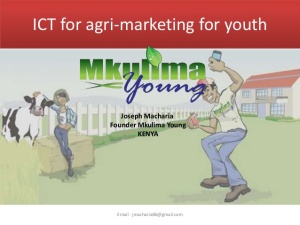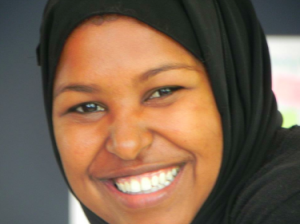
According to the World Bank, agriculture is essential for sub-Saharan Africa’s growth. The sector employs 65 percent of Africa’s labor force and accounts for 32 percent of the region’s gross domestic product. Increased agricultural production is expected to continue to support growth in Africa’s economy.
The demographic in agriculture is however aging rapidly: the average African farmer is between 50 and 60 years old. At the same time, the need for greater agricultural production is acute. In order to feed the projected population of 2050, global food production will need to increase by 60%. That’s about 2.5 million more tons of just grain alone – per day – than we produce right now.
Africa is uniquely positioned to meet this challenge. It contains over half of the world’s undeveloped arable land, great potential for increased crop productivity, and a burgeoning population of young people, with all their energy and creativity.
With 10 to 12 million youth entering the labor market every year, the number of youth ready for employment far outstrips the jobs being created. While a growing number of rural youth are migrating to cities, 70 percent remain in rural areas. Those who stay often lack the skills and knowledge necessary to capitalize on available opportunities. In the long term, youth unemployment can hinder economic growth and lead to political and social unrest.
Africa’s agriculture sector presents unique opportunities for young African leaders who want to serve as change agents on the continent. The sector can also benefit from the resourcefulness, technology savviness and organizational capacity of young people.
More and more young Africans are discovering that they can make farming a profitable career. The Young African Leadership Initiative profiles some of these young agriculture entrepreneurs.
Below are a few that have inspired me:
 In 2014, Djomakon and some friends created the blog “Let’s Be a Farmer,” encouraging African youth to learn more about farming. “The goal is to enhance the image of the African farmer whose daily job is about feeding others, but who happens to be the poorest and least recognized in our societies,” he writes in his blog. Let’s Be a Farmer is a Web-based community platform which would help connect, virtually and physically, two different social groups — farming communities and aspiring young entrepreneurs. The organization recruited 120 nonfarm Beninese youth to go to rural areas and visit with men and women farmers, ranchers and agri-processors.
In 2014, Djomakon and some friends created the blog “Let’s Be a Farmer,” encouraging African youth to learn more about farming. “The goal is to enhance the image of the African farmer whose daily job is about feeding others, but who happens to be the poorest and least recognized in our societies,” he writes in his blog. Let’s Be a Farmer is a Web-based community platform which would help connect, virtually and physically, two different social groups — farming communities and aspiring young entrepreneurs. The organization recruited 120 nonfarm Beninese youth to go to rural areas and visit with men and women farmers, ranchers and agri-processors.
Until recently, many young Kenyans saw farming as an unskilled, unrewarding profession, suitable only for the  retired or the uneducated. A group of determined young farmers are challenging traditional prejudices and trying to explain the attractions of farming as a profession. They are the ‘Mkulima Young Champions’ and have become figureheads for a digital initiative to change the way farmers are viewed by young people. Using a range of technologies, they are proving that farming in Kenya really is a profitable 21st century career path. Mkulima Young is an initiative that encourages youth to engage in agricultural issues. Young farmers share their experiences and challenges problems affecting their productivity and marketing as well as access to inputs. The platform has launched an online market, where young people can sell their produce. The group – Mkulima means “farmer” in Kiswahili – was founded by Joseph Macharia, a farmer and agricultural expert, and is funded by the Rockefeller Foundation. Its aim is to draw more young people into farming, help them learn from each other, trade, and overcome the challenges of agriculture together.
retired or the uneducated. A group of determined young farmers are challenging traditional prejudices and trying to explain the attractions of farming as a profession. They are the ‘Mkulima Young Champions’ and have become figureheads for a digital initiative to change the way farmers are viewed by young people. Using a range of technologies, they are proving that farming in Kenya really is a profitable 21st century career path. Mkulima Young is an initiative that encourages youth to engage in agricultural issues. Young farmers share their experiences and challenges problems affecting their productivity and marketing as well as access to inputs. The platform has launched an online market, where young people can sell their produce. The group – Mkulima means “farmer” in Kiswahili – was founded by Joseph Macharia, a farmer and agricultural expert, and is funded by the Rockefeller Foundation. Its aim is to draw more young people into farming, help them learn from each other, trade, and overcome the challenges of agriculture together.
 Anthony is from a rural part of Delta state in Nigeria. Anthony loved the catfish his mother raised and cooked for family meals throughout his youth. He even enjoyed feeding the fish. Eventually, he determined that fish could provide him with a livelihood. Anthony, 28, raises his stock with care. He buys fingerlings from a friend at a good price, feeds them nutritious commercial feed and regularly checks the quality of the water in his pond, which is connected to a river. It takes six months for fingerlings to grow to the size where they can be harvested and sold. He sells the harvest right on the farm to local women fishmongers, who sell the catfish in local markets.
Anthony is from a rural part of Delta state in Nigeria. Anthony loved the catfish his mother raised and cooked for family meals throughout his youth. He even enjoyed feeding the fish. Eventually, he determined that fish could provide him with a livelihood. Anthony, 28, raises his stock with care. He buys fingerlings from a friend at a good price, feeds them nutritious commercial feed and regularly checks the quality of the water in his pond, which is connected to a river. It takes six months for fingerlings to grow to the size where they can be harvested and sold. He sells the harvest right on the farm to local women fishmongers, who sell the catfish in local markets.
M-Farm is a software solution and agribusiness company that provides a transparent tool for Kenyan farmers and  uses mobile technology to provide access to information pertaining to the retail price of their products, buy their farm inputs directly from manufacturers at favorable prices, and find buyers for their produce. M-farm was developed by a young entrepreneur, Jamila Abass a passionate and adept web and mobile applications developer. Her goal is to empower people at the bottom of pyramid, especially women, with the knowledge to unleash their potential and drive growth in the East African IT sector.
uses mobile technology to provide access to information pertaining to the retail price of their products, buy their farm inputs directly from manufacturers at favorable prices, and find buyers for their produce. M-farm was developed by a young entrepreneur, Jamila Abass a passionate and adept web and mobile applications developer. Her goal is to empower people at the bottom of pyramid, especially women, with the knowledge to unleash their potential and drive growth in the East African IT sector.
What are some of the opportunities for increasing youth engagement in the sector?
Invest in building capacity of young farmers: Planting and tending crops or raising livestock can only get you so far. Knowing what to plant, which breed is suitable for what areas, what market opportunities exist etc is critical. That’s where a little training goes a long way. Programs such as the Strengthening Rural Youth Development through Enterprise (STRYDE) program, a partnership between TechnoServe’s and MasterCard Foundation, trains young people not only in agronomic skills but the business and personal skills that enable them to produce, assess, and take advantage of, local market . The education sector also needs to be reformed to focus on both the theoretical and practical aspects of agriculture and to link agriculture training to entrepreneurship and business management.
Identify agribusiness opportunities beyond the farm: Not all people working in agriculture have to work on the farm. Supporting young people to identify market gaps at all levels can enable them launch businesses beyond the farm that support agricultural activities around them. This could be in agro processing, agriculture research, food technology, agriculture service sector amongst others. The lack of attraction to the agriculture sector by the youth has by and large been contributed by the view that the sector entails ‘farming’, ‘livestock keeping’ and ‘fish farming’ only.
Increase access to finance for young people: Raising sufficient capital is a major problem facing young people who want to get established in farming. Young Farmers Finance Schemes, similar to some of those found in the US such as Rural Finance can support young people’s entry into the agriculture and agri business sectors. These would be finance schemes with lower than normal collateral requirements, alternative collateral such as business plans and lower interest rates geared towards kickstarting young entrepreneurs.
Provide Mentoring: Young agriculture entrepreneurs need mentors that can support them to navigate not only the technical aspects of the sector, but also the business aspects. The International Institute for Tropical Agriculture (IITA) The IITA Youth Agripreneurs are a group of young graduates involved in agribusiness, with the aim of being a unit that would serve as a model to other young people planning to venture into agribusiness and becoming the trainer of trainers. Within one year of their existence, they have established many hectares of maize, cassava, and soybean and also plantain/banana fields. They have also multiplied plantain suckers in the macro-propagation chamber. The activities of the group cut across the value-chains of different crops including cassava, maize, plantain/banana, and soybean. For cassava, the Youth Agripreneurs are into stem multiplication and root production. For maize and soybean, their focus is on seed multiplication (both certified and foundation seeds), whereas for the plantain/banana, they are into sucker multiplication and fruit production. The activities of the group cut across the value-chains of different crops including cassava, maize, plantain/banana, and soybean.
Significant challenges remain in realizing the full potential of Africa’s agriculture: access to finance, land rights, and women’s empowerment are just some of the critical issues to address. But with the right tools and training, the continent’s young people can play a critical role in transforming this sector into the engine of Africa’s development.
There is still a strong need for reforms in the agricultural sector within countries and across regions in Africa. African youth who are passionate about policy reforms can serve as advocates in the public sector, pushing for an enabling environment for agribusinesses to thrive and for the necessary investment in infrastructure.


Reblogged this on Frontiers Academy .
Our government need to encourage our youth in financing their farm project in other to have good result in our production.
This is interesting, I have been looking for such an opportunity to help our group.
I think your website needs some fresh articles.
Writing manually takes a lot of time, but there is tool for
this boring task, search for; ssundee advices unlimited content for your
blog